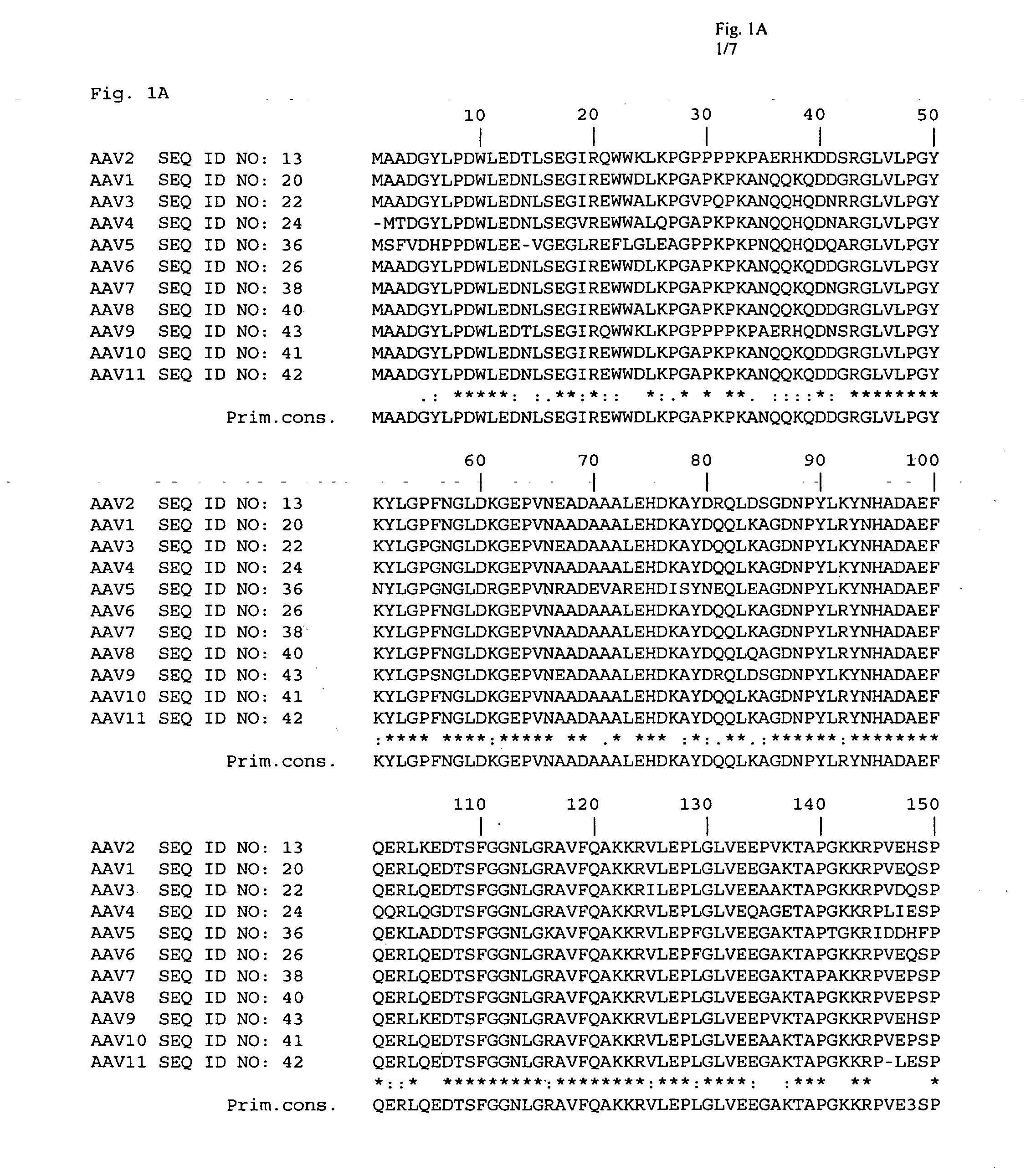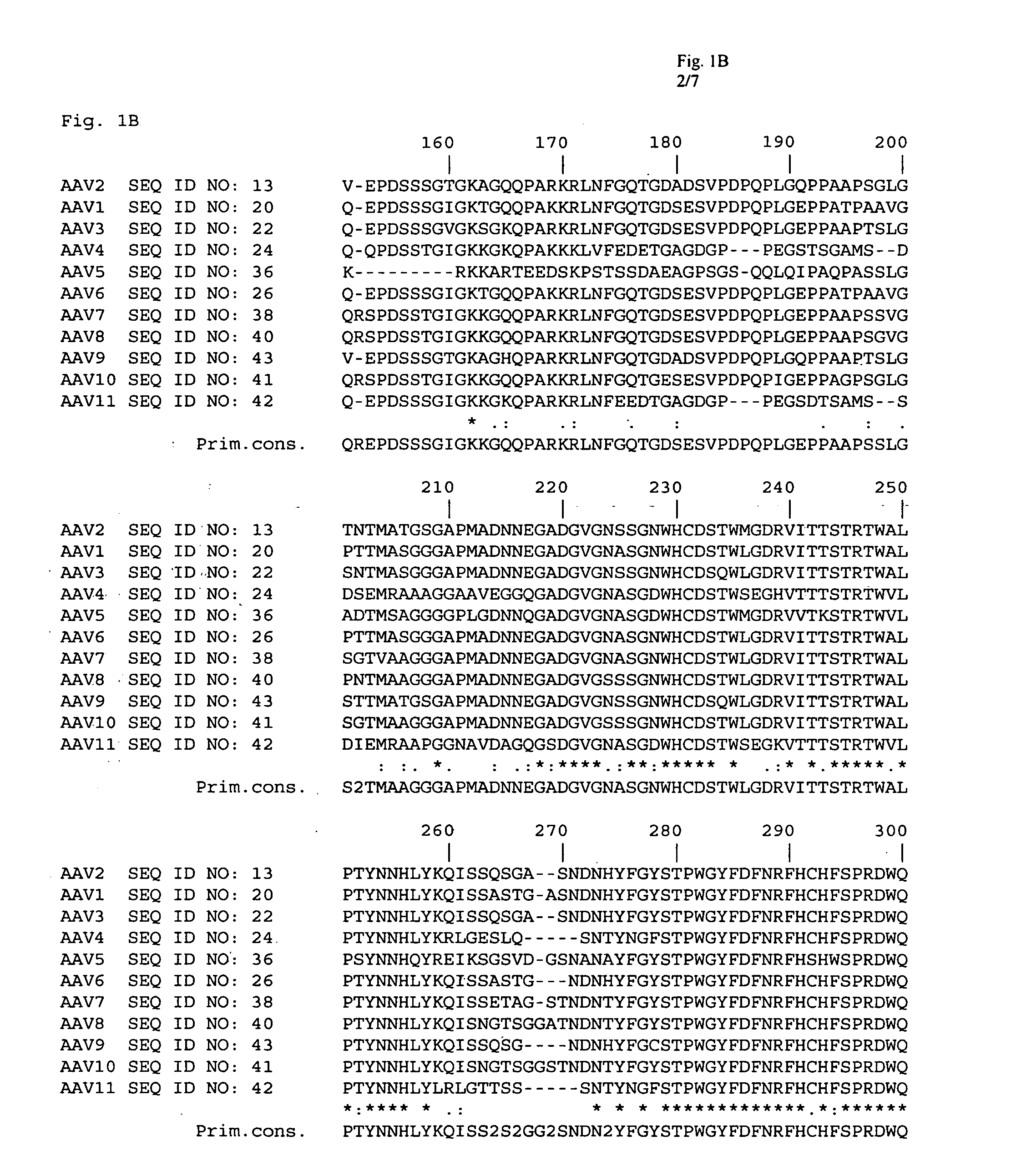AAV vectors and methods
a technology of aav and vector, applied in the field of aav, can solve the problem that aav-infected cells are not resistant to superinfection, and achieve the effect of convenient large-scale production of vectors, simple structure and convenient adaptability
- Summary
- Abstract
- Description
- Claims
- Application Information
AI Technical Summary
Benefits of technology
Problems solved by technology
Method used
Image
Examples
example 1
[0043] In order to identify sites within the AAV2 capsid that could tolerate insertion of targeting epitopes, an extensive site-specific mutagenesis strategy was designed. Regions of the AAV2 capsid DNA to be modified were chosen by analyzing data from a number of sources to predict which ones encoded capsid amino acids that were exposed on the surface of the virion and which encoded amino acids that could be replaced with other amino acids without significantly altering the conformation of the rest of the capsid protein(s). One source of data was a comparison of structural information from five related autonomous parvoviruses. The five parvoviruses had solved virion structures and included canine parvovirus (CPV)(Tsao et al., Science, 251: 1456-1464 and Wu et al., J. Mol. Biol., 233: 231-244), feline panleukopema virus (FPV)(Agbandje et al., Proteins,. 16: 155-171), minute, virus of mice (MVM)(Agbandje-McKenna et al., Structure, 6: 1369-1381 and Llamas-Saiz et al., Acta Crystallogr...
example 2
[0048] The surface accessibility of inserted BPV epitopes in the mutant AAV vectors described in Example 1 was examined by immunoprecipitation.
[0049] Iodixanol grandient-purified vectors were precipitated with anti-BPV monoclonal antibody using protein-G Sepharose, subjected to SDS-PAGE, blotted to nylon membranes and probed with anti-AAV B1 monoclonal antibody. A summary of epitope display for each BPV insertion mutant is shown in Table 3 below.
TABLE 3Surface Display of Inserted BPV EpitopesMutant Vector DesignationEpitope DisplayAAV-A139BPV / GLS+AAV-A161BPV / ALS+AAV-A161BPV / LLA+AAV-A161BPV / GLS+AAV-A339BPV−AAV-A459BPV / GLS+AAV-A520BPV / LLA+AAV-A584BPV / ALS+AAV-A584BPV / LLA+AAV-A584BPV / GLS−AAV-A587BPV / ALS+AAV-A587BPV / LLA−AAV-A587BPV / GLS+
[0050] Inserted peptide epitopes could be displayed efficiently on the surface of viral particles at each site tested which were all sites that insertion gave rise to infectious vectors. However, display was often dependent on inclusion of appropriate l...
example 3
[0051] The mutant AAV vectors of Example 1 were also tested for retention of the ability to bind HSPG.
[0052] The ability of the AAV vectors to bind HSPG was assessed by purifying the AAV preparations on an iodixanol gradient. The 40% iodixanol layer was collected and diluted in PBS-MK containing heparin sulfate affinity resin. The mixtures were incubated for two hours with gentle shaking at 4° C. followed by centrifugation. The viral bound resin was washed three times with PBS-MK for ten minutes at room temperature and resuspended in loading buffer. The samples were then boiled and analyzed by Western blotting with monoclonal antibody B1 directed against the AAV2 VP3 capsid protein. A summary of the HS-binding characteristic for all of the mutant is presented in Table 4 below.
TABLE 4HSPG BindingMutant Vector DesignationHSPG BindingAAV-A26−AAV-A46+AAV-A115-4C-RGD / GLS+AAV-A139+AAV-A139BPV / GLS+AAV-A139LH / GLS+AAV-A161BPV / ALS+AAV-A161LH / GLS+AAV-A312−AAV-A323-4C-RGD / GLS−AAV-A375BPV+AAV...
PUM
| Property | Measurement | Unit |
|---|---|---|
| Fraction | aaaaa | aaaaa |
| Fraction | aaaaa | aaaaa |
| Fraction | aaaaa | aaaaa |
Abstract
Description
Claims
Application Information
 Login to View More
Login to View More - R&D
- Intellectual Property
- Life Sciences
- Materials
- Tech Scout
- Unparalleled Data Quality
- Higher Quality Content
- 60% Fewer Hallucinations
Browse by: Latest US Patents, China's latest patents, Technical Efficacy Thesaurus, Application Domain, Technology Topic, Popular Technical Reports.
© 2025 PatSnap. All rights reserved.Legal|Privacy policy|Modern Slavery Act Transparency Statement|Sitemap|About US| Contact US: help@patsnap.com



